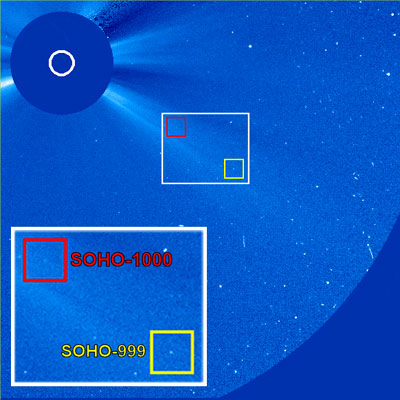Avi Blizovsky

Direct link to this page: https://www.hayadan.org.il/soho1000.html
A thousand comets have been discovered so far using the SOHO spacecraft (the Solar and Heliospheric Observatory). Soho, a satellite shared by NASA and the European Space Agency is responsible for about half of all comets whose orbits have been calculated in the history of astronomy.
Many of the comets photographed by Soho were discovered through enthusiasts who scanned the photos of Soho posted on the Internet. Soho comet hunters come from all over the world. Tony Scarmato, a high school teacher from Italy discovered Soho's 999th and 5th comets on August XNUMXth when they both appeared in the same photo of Soho. Scarmato, a graduate of astrophysics at the University of Bologna said: "I am happy about the experience that is possible thanks to the Soho satellite. I want to dedicate the thousand comet to my wife Rosie and my sons Quinn, as compensation for the time taken from them so that I could search for the thousand comet."
Many of these comets captured in the Soho field of view are all solar comets. Soho looks at the sun, hiding his face but seeing everything around him. These comets are nearing the end of their lives as they orbit the Sun at zero distance from it and it is only a matter of time before they fall into it. Before the Soho launch, only 16 solar comets had been discovered by astronomers. "Based on this experience, who could have predicted that Soho would discover more than 60 times that number, and all this in just nine years?: says Dr. Chris St. Cyr, Senior Scientist of the Soho Project at NASA , at the Goddard Space Flight Center in Maryland.
Comets are lumps of ice and dust floating in the solar system in elongated orbits. These dirty snowballs are comet nuclei. These kernels are cosmic remnants, compressed remnants of the cloud of gas and dust from which the solar system was formed.
When the comet approaches the Sun, the heat radiation releases the gas from the nucleus and creates the halo, a compact and bright cloud that surrounds the nucleus. It lengthens as the sunlight pushes the dust particles away from the sun. Comets also have a tail of electrically charged particles (ions) that are more hollow and are pushed out from the Sun by the solar wind, a gentle stream of ionized gas particles that blows regularly.
About 85 percent of the comets discovered by SOHO are comets from the Kreutz group - solar panels. Their trajectory brings them as mentioned near the sun. Comets 999 and 800 also belong to the Kreutz group. The orbit of these comets brings them up to a distance of 57.6 thousand kilometers from the visible surface of the Sun. (For comparison, Mercury, the closest planet to the Sun, is at an average distance of 55 million kilometers from it (more than a third of the distance to Earth). Soho was also used to discover three more populated groups of comets: Mayer (at least 21 comets), Mardsen ( at least 24) and Cratchett (XNUMX). These groups are named after the astronomers who proposed their existence and their connection due to the similar orbits of comets in each group. Because the comets have similar orbits, researchers believe they are fragments of much larger comets that have broken up. Solar Comets can break apart as they approach the Sun due to the Sun's gravity as well as heat. Smaller fragments almost certainly continue to break apart at all points in their orbits, and this is because Soho has watched a stream of tiny Kreutz comets reach the Sun almost daily, and many others simply evaporate as they approach the Sun. Most of these comet fragments are not visible from Earth because their small size makes them extremely blind. A typical comet nucleus is the size of a mountain, while most of the comets photographed by Soho are barely the size of a large room or a small house.
However, since the Kreutz group contains such a large number of comets, the parent comet that created the Kreutz comets was probably very large, about 100 kilometers in diameter. The large comets of 1843 and 1882, with their eye-popping long tails, were large Kreutz comets, as was Ikea-ski observed in 1965. The comets of 1882 and 1965 almost certainly broke apart at an earlier time as they approached the Sun. The common comet was most likely the one observed in 1106.
Almost all of the Soho comets were discovered by imaging with the Wide Angle Camera and Spectroscopic Coronagraph (LASCO). This instrument is used to observe the hot outer atmosphere of the sun - the corona. A disc in this device is used to make an artificial eclipse and it blocks the direct sunlight so you can see the much paler corona. Solar comets are seen when they pass near the Sun. "Building a coronagraph like Lascaux is still more art than science, because the light we're trying to detect is extremely faint." says Dr. Joe Gorman, Soho Project Scientist at Goddard. "Any deviation in the optics or dust in the device will confuse the light and cause noise in the image, to the point of making it useless. The discovery of a thousand comets since the Soho launch on December 2, 1995, is a testament to the skills of the LASCO team." said.
SOHO actually completed its initial mission in April 1998 and has enough fuel to stay in position and continue to hunt comets for decades, assuming the LASCO instrument continues to function. In addition, a twin spacecraft of NASA - STEREO Solar Terrestrial Relations Observatory (STEREO) is planned for launch in February 2006. Both have the same LASCO instrument.
To the article on the NASA website
They knew asteroids and comets
The solar knower
https://www.hayadan.org.il/BuildaGate4/general2/data_card.php?Cat=~~~244844483~~~18&SiteName=hayadan
